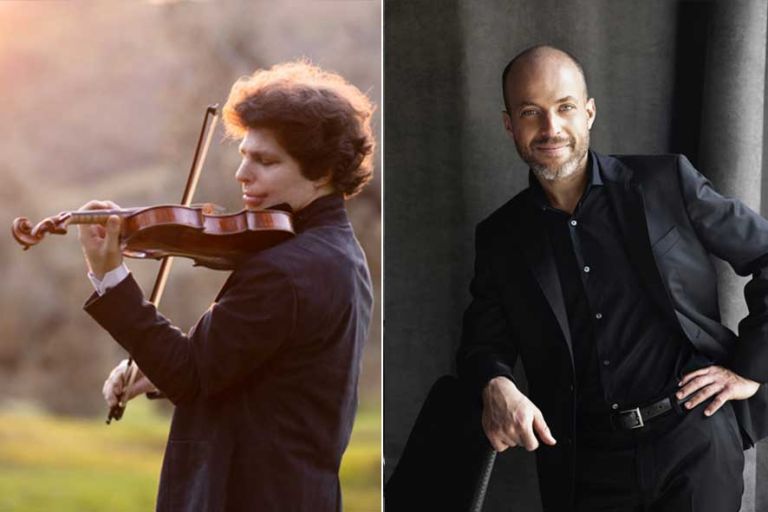With a new Guarneri in tow, Hadelich launches Fortas chamber season in style

Augustin Hadelich and Orion Weiss performed at the Kennedy Center Sunday afternoon.
Augustin Hadelich sold out the Kennedy Center Terrace Theater on Sunday afternoon for the opening performance of this season’s Fortas Chamber Music Concerts series. The violinist played with an astounding assurance and musicality, as he has in every local appearance since his debut in 2009. This time, adding to the appeal, he seemed to have an almost ideal partner in pianist Orion Weiss.
Since Hadelich’s last appearance here, when he was playing a Stradivarius, Hadelich has received the loan in 2020 of an extraordinary violin, the “Leduc” made by Guarneri del Gesù around 1744. This marvelous instrument is sometimes known as the “ex-Szeryng” because it had not been heard in public since the death of its last regular player, Polish violinist Henryk Szeryng, in 1988. Hadelich has brought it to life again.
Hadelich played the “Leduc” with remarkable poise in Beethoven’s Violin Sonata No. 10. The first movement’s opening trill motif, rendered by Hadelich with a slight hesitation and sweetness, set the tone of this sunny piece. The duo rendered all the formal shifts of this first movement with delicacy, from the light arpeggios, with the violin sandwiched in the center of the piano’s twin line, to Weiss’s buoyant take on the second theme.
The surprise shift to B-flat major in the closing theme had just the right sense of wonder, achieved again by a slight hesitation to make it stand out even more. The final statement of these ideas, in the first movement’s coda, felt most nostalgic, in a section featuring fluffy trills from both musicians.
Hadelich’s attention to detail stood out as he took a long pause to retune his strings carefully before the second movement. The scrupulous care for intonation paid dividends in the slow movement, which Hadelich played with heart-melting legato, the many double-stops immaculately tuned.
The compact Scherzo moved along deftly, the off-beat accents noted but without becoming disjointed. Weiss’s only shortcoming was a minor tendency to rush, but Hadelich could touch the brakes just slightly and get an instant response, even while playing an accompanying figure. At the end of this joyful sonata, Beethoven’s addition of a dour, enigmatic fugal section felt like the droll joke it was probably meant to be.
Music in a completely different style, Road Movies by John Adams, was no less compelling or melodic. The musicians, in funny commentary, described this music as depicting the joys of driving, albeit with “some potholes” along the way. Weiss was rock-solid in the mesmerizing, repetitive accompaniment of complex patterns, allowing Hadelich to ride over the top in skittering counter-rhythms in the first movement.
In the second movement, Hadelich took advantage of the scordatura tuning, which lowered his lowest string into the viola’s range, to create a nocturnal aura over the more melancholy piano. The third movement put the pedal to the metal, as it were, a wild ride at a galloping tempo, with squealing double-stop glissandi in the violin as Hadelich rounded some corners.
Daniel Bernard Roumain’s Filter struck a similar tone to lead off after intermission. A solo violin tribute to the enigmatic guitar solos of Jimi Hendrix, the piece featured soulful blue notes and some high screeching sounds. In the fast-paced second section, Hadelich established a blistering groove, his left hand’s flashy fingering a blur. His bowing approached the bridge to give the sound of a distortion pedal, hence the work’s title.
The evening’s most tragic music came in Prokofiev’s Violin Sonata No. 1, one of the composer’s wartime works, begun in 1938 and completed after World War II in 1946. Here Hadelich really put the “Leduc” through its paces, with throaty G-string trills and searing double-stops in the first movement, over the piano’s menacing octaves. The ghostly runs toward the end, which Prokofiev said should sound like “wind through a graveyard,” have rarely sounded as haunting.
The outer sections of the brutal second movement bristled with hammered accents in both instruments, with a more romantic middle section that borders on maudlin in its expressivity. Flowing triplets characterized the third movement, with gorgeous legato tone from Hadelich. As he had done in the Adams, Weiss’s precision gave the fast, athletic Finale a visceral edge. The booming octaves of his left hand punctuated the movement like gunfire, setting up that eerie return of the sepulchral runs from the first movement.
After so much heartless cruelty in the Prokofiev, Hadelich turned to guiltless melody in the final selection, Amy Beach’s Romance, Op. 23. With swooning vibrato and portamenti, Hadelich made the “Leduc” sing in this aching melody, up to a sweet, floating high C-sharp on the final chord. A sparkling encore provided a completely different American sound: the refreshing Black Gypsy by Eddie South, the Missouri-born black violinist who trained in classical music but made his name in jazz.
The Emerson String Quartet gives its final concert on the Fortas series 7:30 p.m. October 20. kennedy-center.org
